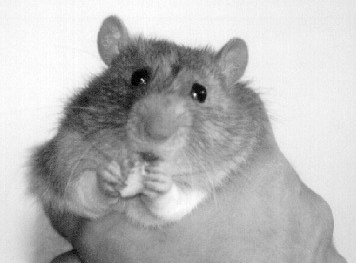
Rattus Biologicus:
Coprophagy: Healthy Behavior For Your Rats
If you're anything like me, you are a fastidious keeper of your rats' habitat.Every night I spend a few minutes picking the droppings and moist bedding outof my boys' cages. It definitely helps to control odor, plus improves theappearance of their cages, which in turn increases the chance of non-ratophiles regarding them as "acceptable" pets. However, the presence offecal matter is not such a bad thing for your rats. In fact, eating fecalpellets is a nutritional requirement of rats and other rodents.
Coprophagy is officially defined as "the feeding or eating of dung orexcrement that is normal behavior among many insects, birds, and otheranimals." This behavior was first recognized in 1882 in rabbits, and occursin many animals including mice, guinea pigs, beavers, dogs, foals, pigs, non-human primates, and rats. Rats actually consume anywhere from 5 to 50% of thetotal amount of fecal matter they produce. This process provides the rat someessential nutrients that it cannot obtain from the initial passage of foodthrough the digestive tract. One may not give much thought to the lazychewing of the cud that we observe cows doing all the time, but this behavioris analogous to coprophagy. The only difference between cud chewing andcoprophagy is the point in the digestive tract at which nutrients are expelledand then placed back into the mouth.

Tricki Woo likes pancakes...
and fecal pellets, too!
Photo by Dan Conklin
The digestion of certain foodstuffs, such as plant matter (containing thelarge polysaccharide cellulose) is very time-consuming and requires muchspace. The digestive tracts of animals that consume these foods arespecialized to deal with this process. Rats and ruminants, like all mammals,lack the enzymes necessary to digest cellulose down to simple sugars, makingplant material a generally poor foodstuff. However, microorganisms (bacteria)exist in certain areas of their digestive tracts, and these bacteria do have the enzymes.
Ruminants (cows, goats, sheep, etc.) have multi-compartmented stomachs. Oneof these compartments, the rumen, is an enlarged section in which bacteriathrive. Through bacterial fermentation here, large food particles are brokendown. Ruminants owe their name to their habit of expelling some of the foodcontent of the first stomach compartment back to the mouth for furtherchewing. After the food is chewed, it is passed to the rumen. This re-chewing of the "cud" functions to break down the food further, increasing thesurface area of particles available to the action of bacterialdigestive enzymes in the rumen.
Rats, on the other hand, have simple stomachs that are not multi-compartmented. However, they still depend upon microbial fermentation todigest from 1/3 to 1/2 of the plant material they eat. The difference betweenrats and ruminants is the point in the digestive tract where this fermentationoccurs. In the rat, the cecum is home to the fermenting bacteria. The cecumis an out-pocketing of the terminal portion of the small intestine, at thepoint where it connects to the large intestine. The first pass of food throughthe digestive tract does not provide much opportunity for the bacteria to acton food - ingested particles are of a coarse consistency. This is why ratsmust re-ingest their fecal pellets. Re-chewing the food particles breaks themdown further, providing more surface area for the bacteria in the cecum to act upon.
The resident bacteria also produce valuable nutrients as a by-product offood breakdown. Therefore, a part of the benefit from these microorganisms isderived by placing them back into the area of absorption in the digestivetract -- the small intestine. This is accomplished via coprophagy. So, youcan see that coprophagy is of great nutritional significance; it provides asource of vitamins, minerals, trace elements and other nutrients that areexcreted in the feces and otherwise not effectively absorbed in the digestive tract.
Besides increasing the nutritional benefits of their food, coprophagy mayalso have more unexpected benefits. The advantageous effects of penicillinare abolished when coprophagy is prevented. A biologically active substanceis excreted in the feces when penicillin is given, and this substance exertsits beneficial effect only after the oral ingestion of feces. In addition,rats that are allowed to consume feces are better able to digest all foodeaten, most notably proteins.
So, the next time you observe those fecal droppings in your rats' cage, don'tbe tempted to pick them all out for cleanliness' sake. For your rats' health,now you know to leave a couple of those nutrition-packed pellets behind!
Caryl has a B.S. in Zoology from Texas A&M University and an M.S. in Biologyfrom the University of Notre Dame. She currently works as a researchassistant at the University of Texas Medical Branch at Galveston. She livesin Galveston, Texas, with her husband, Dan, and Siegfried the rat.
Questions or comments may be directed to Caryl at Branta1@aol.com.